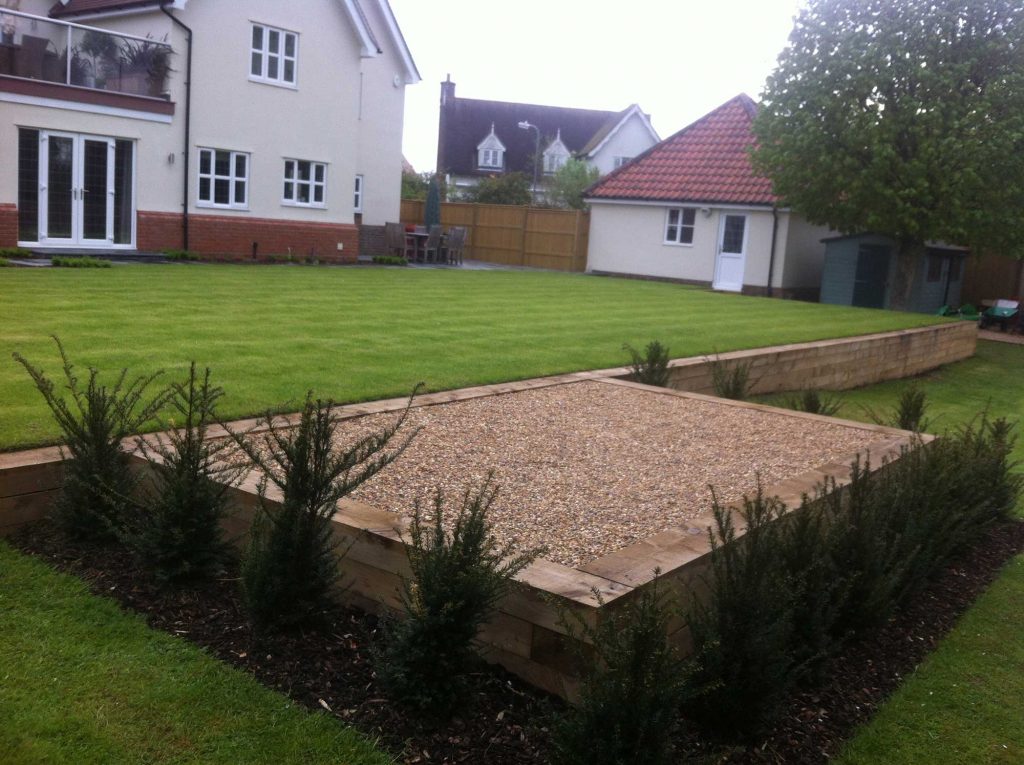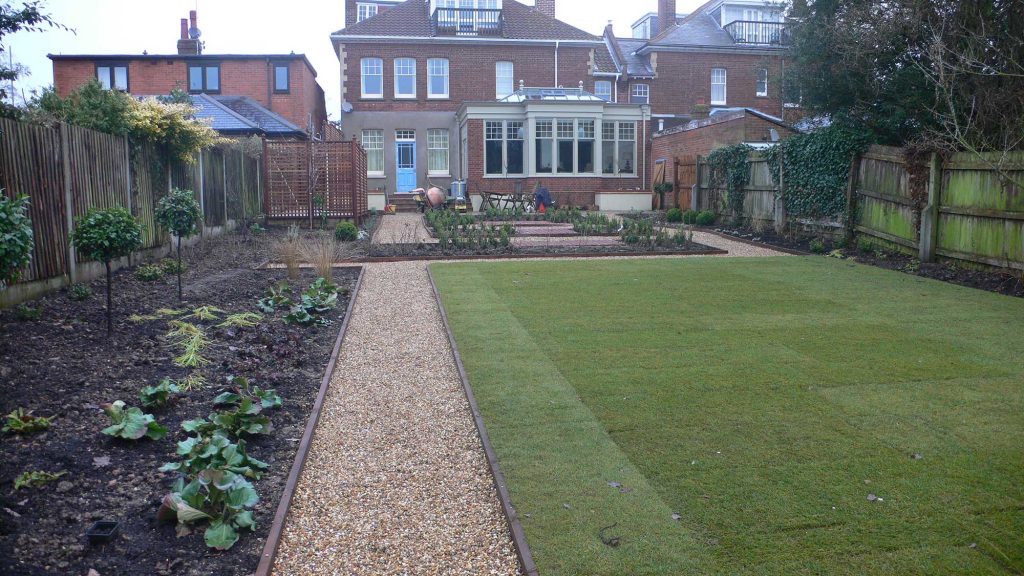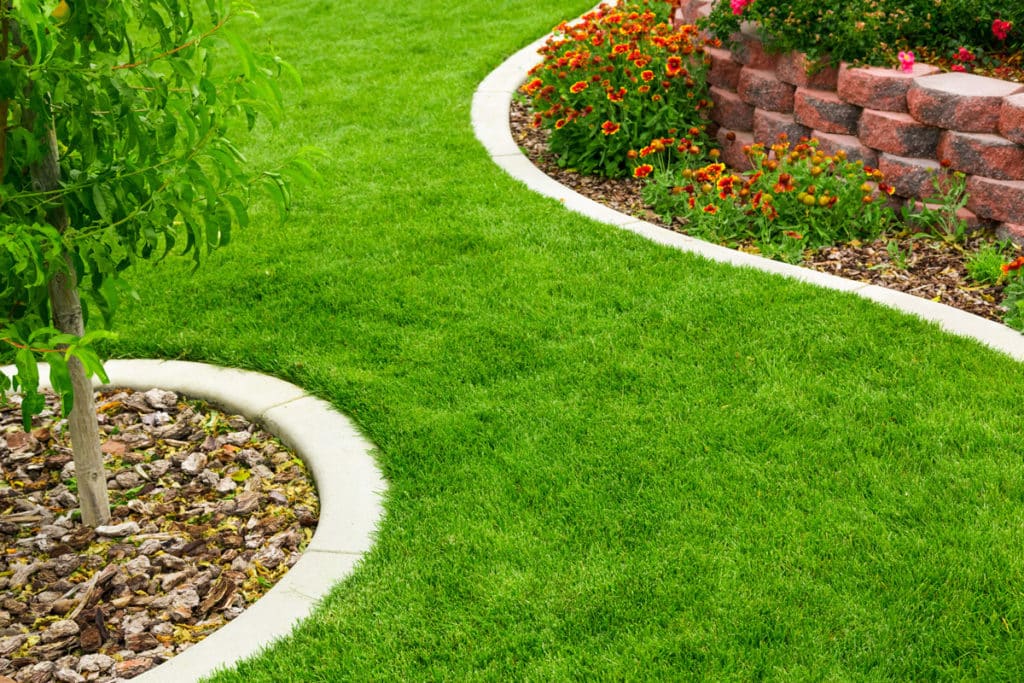11 Mar Landscaping and Lawn Care
Landscaping and lawn care are two very different skill sets, but one has an enormous influence on the other. Let’s take a look.
How Landscaping And Lawn Care Are Intertwined
The basis of creating a really good lawn lies in the landscaping that goes before it. When the landscaping is done carefully, the lawn will establish well and be easy to care for. Lazy landscaping leads to lawn faults that can take years to rectify.
So what does a landscaper do to make ongoing lawn maintenance easier?
- Designing the garden so that a lawn can thrive
- Inserting hard landscaping features such as edging and/or stepping stones
- Creating access points for the mower
- Ensuring that the lawn area is properly drained
- Making sure that the soil is deep enough and the right quality to sustain the plants
- Installing irrigation if required
- Levelling the ground so that the lawn is easy to mow
- Laying turf really well
Level surfaces and neat edges means that this lawn looks fantastic all year round
Lawn Care And Garden Design
OK – so not all landscapers profess to be garden designers, but whoever you choose to design the layout of your garden, will need to consider the best position for your lawn.
Usability and aesthetics are of course important in garden design and landscaping. But so is ‘right plant right place’. If a lawn is positioned in the wettest, gloomiest part of the garden, it will always be a challenge to look after.
Grass needs decent drainage (but not soil that is too dry!) and plenty of sunshine. A big part of autumn lawn care is sweeping leaves off the lawn. If your design avoids putting the lawn beneath deciduous trees, you will save yourself hours of raking!
Combatting wear and tear is another challenging aspect of lawn care. Try to place garden features in such a way that you won’t be traipsing backwards and forwards across the same piece of lawn to get to them. If that’s not possible, ask your landscaper to put in some stepping stones to take some of the stress away from the grass plants.
Don’t forget the mower! When landscaping a sloping garden, it’s not unusual to pop the lawn onto a raised terrace. If you are a lawn care aficionado and have a beautiful cylinder mower, you might struggle to get it up the steps. Ask your garden designer or landscaper to come up with a solution BEFORE you start creating your lawn. Perhaps having a shed on the same level as the lawn, or designing a sloped access point.
Drainage For Your Lawn
Many of the gardens built by the Holland Landscapes team are on a clay based soil. It’s brilliant at retaining nutrients but tends to be soggy in the winter. It’s not unusual for the garden to have a particularly boggy bit either.
Grass doesn’t enjoy growing in waterlogged conditions. There are literally billions of tiny roots beneath your lawn and they all need air to breath. Soil normally has minuscule pockets of air between the particles but if it gets too wet, the water pushes the air out. When deprived of air for days on end, the roots will drown.
So, if you know that your garden has drainage problems, ask your landscaper to come up with a solution. That may involve diverting rainwater runoff from hard surfaces away from the lawn. Or it may be installing land drains beneath the grass. The solution needs to be tailored to your garden.

The timber retaining wall in this garden acts as an edging for the formal lawn on the upper terrace.
Lawn Edgings
Neat edges will always show a lawn off in its best light. If there’s one way that landscaping and lawn care are truly intertwined it’s in using hard landscaping materials to define the edges of a lawn and make sure they are easy to maintain.
Depending on the style of your garden you might opt for a contemporary metal edging or perhaps a pretty edging made from clay pavers. Edgings stop the lawn from encroaching on neighbouring materials and vice versa. For example, a metal edging between the lawn and a gravel path will ensure a clear demarkation between the two for a very long time.
If you are clever, you can get the top of your edgings and/or stepping stones and just the right height so that you can run over them with your mower and trim the edges at the same time.
Soil Quality For Growing A Lawn
There are lawns, and then there are patches of grass. And the difference between the two often comes down to soil quality. Once a lawn is established, it’s very difficult to make big improvements in the soil structure. It’s logical therefore that landscaping and lawn care need to combine to get the soil right before any seeds are sown.
The minimum depth of topsoil for growing a lawn is 150mm. It needs to be firm but friable, able to hold water without becoming waterlogged and the right pH so that the plants can easily access nutrients. The ideal lawn making soil will also be free from perennial weeds, large stones and debris.
Test the depth of your topsoil by pushing a 15cm long screwdriver into the lawn area. If you need to use a lot of effort to do that – the soil is either too shallow or too compacted.
For friability, grab a handful of soil and squeeze it. Perfect lawn soil will form a nugget that easily falls apart if you prod it with your finger. If your soil doesn’t hold together when squeezed, it’s a bit too sandy. Should the soil ‘nugget’ refuses to crumble when poked – the soil profile contains too much clay.
If you and your landscaper decide that the natural soil in your plot is not ideal for lawn making. Be prepared to dig it out and replace it with imported topsoil. Or get ready for a lifetime of aerating and topdressing in order to gradually improve the soil beneath your lawn.

The lawn edging in this garden is really effective at keeping the gravel off the lawn and vice versa. It’s used around the garden to help connect the various garden elements for a cohesive look and feel.
Levelling Your Lawn
The way your lawn looks depends mainly on how the light bounces off the blades of grass. Short grass has a different appearance to longer grass. Bare soil, weeds and moss look altogether different to grass.
If your lawn isn’t completely level, you will see darker patches in the hollows (where the grass is longer) and very pale patches on the hills where the grass may have been scalped by the mower. Those scalped areas are also more likely to have areas of bare soil where weeds can establish.
Levelling an area of soil before seeding or turfing is hard work and best left to the experts. It’s another area where landscaping and lawn care are intertwined.
Levelling involves raking to break down large lumps and distribute the soil evenly over the whole area. Then it needs to be firmed down so that it won’t sink when you start using the lawn. Finally, it needs levelling all over again to loosen the top centimetre or so and check that it really is flat. It’s hard physical work and very time consuming.
Turf Laying
If you have chosen to make your lawn from turf, you may well need help from your landscaper. Turf laying isn’t complicated but it needs to be completed within hours of your turf being delivered – so you need to work quickly. For a small lawn, you can probably do it yourself. But if you have a larger area to turf, it’s a good idea to have plenty of help. Turfing is hard on your back and more tiring than it looks on a YouTube video.
Help With Landscaping And Lawn Care
If you are planning a lawn makeover and need help to prepare the soil and/or lay turf, the Holland Landscapes team are here to help. We don’t offer a lawn care service, but we can ensure that your new lawn is easy for you to look after yourself.
Call or email us today for a quote.
Read more about our turfing services.
What are the alternatives to grass lawns?
For lawn care advice, talk to our team and subscribe to this fantastic lawn care channel on YouTube.





Sorry, the comment form is closed at this time.